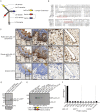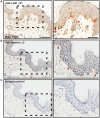Laminin N-terminus α31 protein distribution in adult human tissues
- PMID: 33264294
- PMCID: PMC7710073
- DOI: 10.1371/journal.pone.0239889
Laminin N-terminus α31 protein distribution in adult human tissues
Abstract
Laminin N-terminus α31 (LaNt α31) is a netrin-like protein derived from alternative splicing of the laminin α3 gene. Although LaNt α31 has been demonstrated to influence corneal and skin epithelial cell function, its expression has not been investigated beyond these tissues. In this study, we used immunohistochemistry to characterise the distribution of this protein in a wide-array of human tissue sections in comparison to laminin α3. The data revealed widespread LaNt α31 expression. In epithelial tissue, LaNt α31 was present in the basal layer of the epidermis, throughout the epithelium of the digestive tract, and in much of the epithelium of the reproductive system. LaNt α31 was also found throughout the vasculature of most tissues, with enrichment in reticular-like fibres in the extracellular matrix surrounding large vessels. A similar matrix pattern was observed around the terminal ducts in the breast and around the alveolar epithelium in the lung, where basement membrane staining was also evident. Specific enrichment of LaNt α31 was identified in sub-populations of cells of the kidney, liver, pancreas, and spleen, with variations in intensity between different cell types in the collecting ducts and glomeruli of the kidney. Intriguingly, LaNt α31 immunoreactivity was also evident in neurons of the central nervous system, in the cerebellum, cerebral cortex, and spinal cord. Together these findings suggest that LaNt α31 may be functionally relevant in a wider range of tissue contexts than previously anticipated, and the data provides a valuable basis for investigation into this interesting protein.
Conflict of interest statement
The authors have declared that no competing interests exist.
Figures










Similar articles
-
Laminin N-terminus α31 is upregulated in invasive ductal breast cancer and changes the mode of tumour invasion.PLoS One. 2022 Mar 1;17(3):e0264430. doi: 10.1371/journal.pone.0264430. eCollection 2022. PLoS One. 2022. PMID: 35231053 Free PMC article.
-
Laminin N-terminus α31 expression during development is lethal and causes widespread tissue-specific defects in a transgenic mouse model.FASEB J. 2022 Jul;36(7):e22318. doi: 10.1096/fj.202002588RRR. FASEB J. 2022. PMID: 35648586 Free PMC article.
-
Differential Distribution of Laminin N-Terminus α31 Across the Ocular Surface: Implications for Corneal Wound Repair.Invest Ophthalmol Vis Sci. 2018 Aug 1;59(10):4082-4093. doi: 10.1167/iovs.18-24037. Invest Ophthalmol Vis Sci. 2018. PMID: 30098195 Free PMC article.
-
Laminin 5 processing and its integration into the ECM.Matrix Biol. 2003 Mar;22(1):49-54. doi: 10.1016/s0945-053x(03)00013-1. Matrix Biol. 2003. PMID: 12714041 Review.
-
Dystroglycan and laminins: glycoconjugates involved in branching epithelial morphogenesis.Exp Lung Res. 1997 Mar-Apr;23(2):109-18. doi: 10.3109/01902149709074024. Exp Lung Res. 1997. PMID: 9088921 Review.
Cited by
-
Organization of the laminin polymer node.Matrix Biol. 2021 Apr;98:49-63. doi: 10.1016/j.matbio.2021.05.004. Epub 2021 May 21. Matrix Biol. 2021. PMID: 34029691 Free PMC article.
-
Laminin N-terminus α31 is upregulated in invasive ductal breast cancer and changes the mode of tumour invasion.PLoS One. 2022 Mar 1;17(3):e0264430. doi: 10.1371/journal.pone.0264430. eCollection 2022. PLoS One. 2022. PMID: 35231053 Free PMC article.
-
Laminin Polymerization and Inherited Disease: Lessons From Genetics.Front Genet. 2021 Aug 12;12:707087. doi: 10.3389/fgene.2021.707087. eCollection 2021. Front Genet. 2021. PMID: 34456976 Free PMC article. Review.
-
Laminin N-terminus α31 expression during development is lethal and causes widespread tissue-specific defects in a transgenic mouse model.FASEB J. 2022 Jul;36(7):e22318. doi: 10.1096/fj.202002588RRR. FASEB J. 2022. PMID: 35648586 Free PMC article.
References
Publication types
MeSH terms
Substances
Grants and funding
LinkOut - more resources
Full Text Sources

